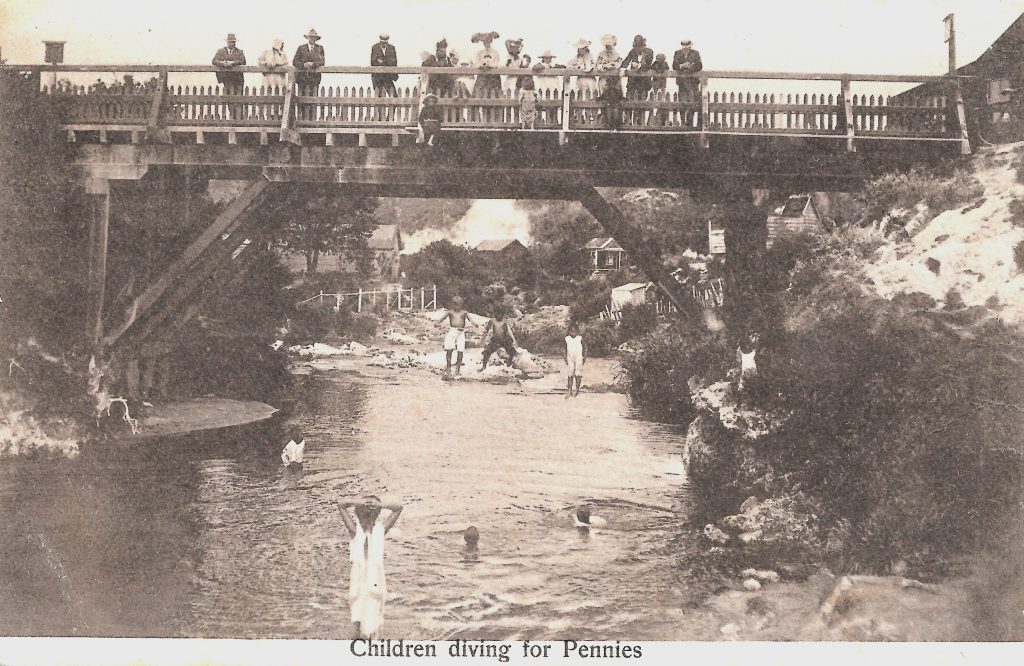Mary Irvine
Māori Children Diving for Pennies

This postcard is not just a picture of a bridge. The image captures a scene in which there is a bridge, but at the same time there is a great deal of action in the photo for the caption tells that this scene shows “Children diving for pennies.”
As for the bridge, it isn’t a big fancy bridge like the Golden Gate, and it isn’t ornate like the Bridge of Sighs, it’s just a small, ordinary bridge built over a stream in Rotorua, New Zealand that has become quite famous! It is famous because it is where local Māori children have learned to jump off the bridge to retrieve pennies that tourists throw into the stream below. This has happened since the early 1900s and no one remembers why.
The children are descendants of an ancient civilization of people associated with the South Pacific islands and particularly mainland New Zealand. It has been discovered that the Māori gathered in New Zealand at the end of several canoe voyages that happened between 1320 and 1350.
With an up-close look you can see several tourists: well-dressed ladies wearing large hats and Edwardian-style dresses and men wearing suits, ties and hats. When the tourists visit the bridge, the small children (mostly boys) perch on the edge of the bridge ready to jump into the stream, to earn the right to keep the pennies they find.
The card was mailed from Rotorua to the sender’s daughter in Wellington in January 1907. The message, signed, “Love from Mother,” tells that she saw the children diving for pennies that day.
Rotorua is a city located in a geothermal area on New Zealand’s North Island of Aoteoroa. Geysers, boiling mud pools and hot springs are commonplace there and most are in parks and tourist areas. However, steam often streams from the gutters around the city and the local swimming baths, spas and some private pools use thermally heated water in their homes. Madge’s mother was seeing first-hand some of the mud pools and enjoying the heated bathing pools in which visitors can soak.
Rotorua is only an hour from where I grew up; we visited often, but I had to check to learn to whom the bridge belonged. Online historic photos confirmed it was at Whakarewarewa. The Māori have lived there for several centuries, taking advantage of the geothermal activity for heating, bathing, and cooking.
When Europeans began arriving in the 1800s, they were fascinated by the local way of life and also took advantage of the geothermal resources, and a tourist attraction was born.
Today, Whakarewarewa is home to twenty-one families. They live and continue to make use of the same geothermal resources used by their ancestors. They also carry on the legacy of their predecessors, who pioneered tourism in New Zealand, by welcoming visitors into their homes and sharing their lives.
Contrary to common sense, children still jump off the bridge, perhaps still chasing pennies, although why the health and safety people allow it, I’m not quite sure!
Another great article from Mary.
Thanks, Bob.
Diving for coins was duplicated decades later at the Subic Bay Naval base. Life expectancy of the poor children who exposed them self to the contaminated waters was short. To support their elders it was something they had to do, no options. Exposure to how other parts of the world function makes this site exceptional.
Thanks Burgie Dave, I didn’t know about the Subic Bay children. Yes, it is great to have a range of authors from around the world.
Another little slice of interesting history. Collecting postcards really opens up many avenues of thought ! thanks
I’m glad you found it interesting, Nelda.
I have several modern postally-used cards postmarked “Rotorua — The Thermal Wonder”, but none feature Maori children diving for pennies (which were last minted in New Zealand in 1987, and demonetized, along with two-cent coins, in 1990).
Actually Bob here in New Zealand we swapped to decimal currency on 10 July 1967 and have been using dollars and cents ever since so no pennies have been produced since we changed over. That last sentence was actually written by the editor not me. He probably did not realise that we don’t still have pennies here or that we don’t refer to cents as pennies as I think they may do in the States.
Good to hear that you have some Rotorua postcards.
I’e acquired few Maori chiefs postcards celebrating their tattoes almost complete covering their faces. Very intriquing images..do they still do that today?
Yes, Richard, a number of Maori choose to have facial tattoos. Great to hear that you have some Maori chief postcards. Women usually have a chin tattoo (moko) . Some men, such as one of our Members of Parliament, choose to have a full facial tattoo.. here is a link you may like to look at. https://www.newzealand.com/int/feature/ta-moko-maori-tattoo/
What an interesting piece of history! We also have such “daredevils” here in the Philippines.
Thank you Mary Irvine for the link on Maori tattoos and also for the interesting article. I believe native people also jump for tourist money in Mexico – it seems to me I have a post card of that act.